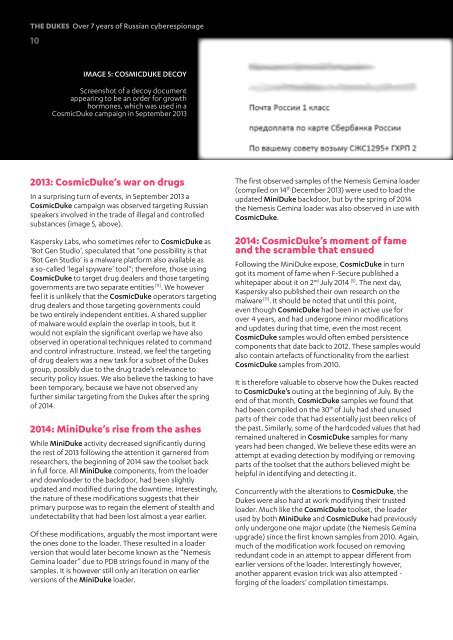THE DUKES
KfG7I6
KfG7I6
Create successful ePaper yourself
Turn your PDF publications into a flip-book with our unique Google optimized e-Paper software.
<strong>THE</strong> <strong>DUKES</strong> Over 7 years of Russian cyberespionage<br />
10<br />
IMAGE 5: COSMICDUKE DECOY<br />
Screenshot of a decoy document<br />
appearing to be an order for growth<br />
hormones, which was used in a<br />
CosmicDuke campaign in September 2013<br />
2013: CosmicDuke’s war on drugs<br />
In a surprising turn of events, in September 2013 a<br />
CosmicDuke campaign was observed targeting Russian<br />
speakers involved in the trade of illegal and controlled<br />
substances (image 5, above).<br />
Kaspersky Labs, who sometimes refer to CosmicDuke as<br />
‘Bot Gen Studio’, speculated that “one possibility is that<br />
‘Bot Gen Studio’ is a malware platform also available as<br />
a so-called ‘legal spyware’ tool”; therefore, those using<br />
CosmicDuke to target drug dealers and those targeting<br />
governments are two separate entities [11] . We however<br />
feel it is unlikely that the CosmicDuke operators targeting<br />
drug dealers and those targeting governments could<br />
be two entirely independent entities. A shared supplier<br />
of malware would explain the overlap in tools, but it<br />
would not explain the significant overlap we have also<br />
observed in operational techniques related to command<br />
and control infrastructure. Instead, we feel the targeting<br />
of drug dealers was a new task for a subset of the Dukes<br />
group, possibly due to the drug trade’s relevance to<br />
security policy issues. We also believe the tasking to have<br />
been temporary, because we have not observed any<br />
further similar targeting from the Dukes after the spring<br />
of 2014.<br />
2014: MiniDuke’s rise from the ashes<br />
While MiniDuke activity decreased significantly during<br />
the rest of 2013 following the attention it garnered from<br />
researchers, the beginning of 2014 saw the toolset back<br />
in full force. All MiniDuke components, from the loader<br />
and downloader to the backdoor, had been slightly<br />
updated and modified during the downtime. Interestingly,<br />
the nature of these modifications suggests that their<br />
primary purpose was to regain the element of stealth and<br />
undetectability that had been lost almost a year earlier.<br />
Of these modifications, arguably the most important were<br />
the ones done to the loader. These resulted in a loader<br />
version that would later become known as the “Nemesis<br />
Gemina loader” due to PDB strings found in many of the<br />
samples. It is however still only an iteration on earlier<br />
versions of the MiniDuke loader.<br />
The first observed samples of the Nemesis Gemina loader<br />
(compiled on 14 th December 2013) were used to load the<br />
updated MiniDuke backdoor, but by the spring of 2014<br />
the Nemesis Gemina loader was also observed in use with<br />
CosmicDuke.<br />
2014: CosmicDuke’s moment of fame<br />
and the scramble that ensued<br />
Following the MiniDuke expose, CosmicDuke in turn<br />
got its moment of fame when F-Secure published a<br />
whitepaper about it on 2 nd July 2014 [5] . The next day,<br />
Kaspersky also published their own research on the<br />
malware [11] . It should be noted that until this point,<br />
even though CosmicDuke had been in active use for<br />
over 4 years, and had undergone minor modifications<br />
and updates during that time, even the most recent<br />
CosmicDuke samples would often embed persistence<br />
components that date back to 2012. These samples would<br />
also contain artefacts of functionality from the earliest<br />
CosmicDuke samples from 2010.<br />
It is therefore valuable to observe how the Dukes reacted<br />
to CosmicDuke’s outing at the beginning of July. By the<br />
end of that month, CosmicDuke samples we found that<br />
had been compiled on the 30 th of July had shed unused<br />
parts of their code that had essentially just been relics of<br />
the past. Similarly, some of the hardcoded values that had<br />
remained unaltered in CosmicDuke samples for many<br />
years had been changed. We believe these edits were an<br />
attempt at evading detection by modifying or removing<br />
parts of the toolset that the authors believed might be<br />
helpful in identifying and detecting it.<br />
Concurrently with the alterations to CosmicDuke, the<br />
Dukes were also hard at work modifying their trusted<br />
loader. Much like the CosmicDuke toolset, the loader<br />
used by both MiniDuke and CosmicDuke had previously<br />
only undergone one major update (the Nemesis Gemina<br />
upgrade) since the first known samples from 2010. Again,<br />
much of the modification work focused on removing<br />
redundant code in an attempt to appear different from<br />
earlier versions of the loader. Interestingly however,<br />
another apparent evasion trick was also attempted -<br />
forging of the loaders’ compilation timestamps.


